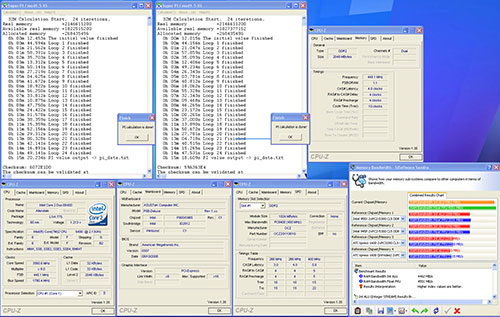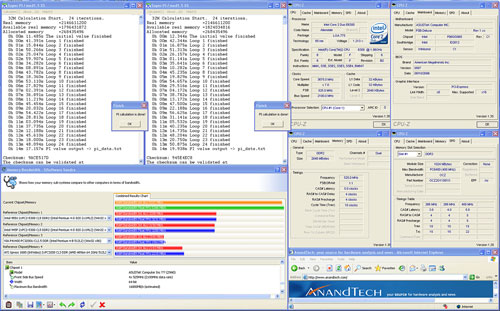ASUS P5B: New BIOS Adds Unlocking & Improved Overclocking
by Wesley Fink on August 24, 2006 3:00 PM EST- Posted in
- Motherboards
As more experience has been gained in overclocking Core 2 Duo chips, it is becoming clear that the 4MB cache E6700 and E6600 do not overclock quite as well as the 2MB Cache chips. There is not a huge difference in the overclocking of 2MB and 4MB at each multiplier, but there is a small advantage to the 2MB design for overclocking. Keep in mind, however, that 2MB performance is lower, so that tends to offset any advantage the 2MB E6400 and E6300 designs might enjoy.
E6400
The E6400 starts at 8x266 or 2.13GHz. With the new 507 BIOS we managed to reach stable speeds of 445x8, 511x7, and 514x6. This composite should give you a better idea of performance at a FSB of 445x8. There is a huge amount of capture information in this image, so you will need to click to enlarge it to readable size.
The jump from 2.13GHz to 3.58GHz is an amazing overclock of 1449MHz, or almost 1500 MHz. Percentage wise, this is a bit more than 68%. With the new ASUS BIOS, we now have the ability to do similar overclocks with the bus speed. With the 6400 the bus speed can now be adjusted from 266 to 514, which represent s a potential bus speed overclock of 93% - almost double the stock 266 FSB speed.
E6300
At $183 the E6300 represents the best value among the Core 2 Duo processors. The 65nm architecture combined with a low starting speed of 1.83GHz presents buyers with some amazing overclocking potential. These capabilities are enhanced further with the ASUS 0507 BIOS.
The E6300 unlocked down and reached 525x7 at stock multiplier. We were very near the limits of the ASUS P5B with the new BIOS and Scythe Infinity air cooling since dropping to x6 only gained us a few more MHz on the FSB, namely 532 at 6X. This is a100% bus overclock and it clearly demonstrates the added flexibility of the lower speed Core 2 Duo chips.
While the 2MB cache E6400 and E6300 reached higher bus speeds and CPU clocks than the 4MB E6700 and E6600, keep in perspective that the 4MB versions perform faster clock for clock. Any advantage the 2MB might have in our testing is small and is more than offset by the 4MB performance advantage. Still, the 2MB models are definitely impressive overclockers and they are both excellent values in the Core 2 Duo line-up.
E6400
The E6400 starts at 8x266 or 2.13GHz. With the new 507 BIOS we managed to reach stable speeds of 445x8, 511x7, and 514x6. This composite should give you a better idea of performance at a FSB of 445x8. There is a huge amount of capture information in this image, so you will need to click to enlarge it to readable size.
 |
| Click to enlarge |
The jump from 2.13GHz to 3.58GHz is an amazing overclock of 1449MHz, or almost 1500 MHz. Percentage wise, this is a bit more than 68%. With the new ASUS BIOS, we now have the ability to do similar overclocks with the bus speed. With the 6400 the bus speed can now be adjusted from 266 to 514, which represent s a potential bus speed overclock of 93% - almost double the stock 266 FSB speed.
E6300
At $183 the E6300 represents the best value among the Core 2 Duo processors. The 65nm architecture combined with a low starting speed of 1.83GHz presents buyers with some amazing overclocking potential. These capabilities are enhanced further with the ASUS 0507 BIOS.
 |
| Click to enlarge |
The E6300 unlocked down and reached 525x7 at stock multiplier. We were very near the limits of the ASUS P5B with the new BIOS and Scythe Infinity air cooling since dropping to x6 only gained us a few more MHz on the FSB, namely 532 at 6X. This is a100% bus overclock and it clearly demonstrates the added flexibility of the lower speed Core 2 Duo chips.
While the 2MB cache E6400 and E6300 reached higher bus speeds and CPU clocks than the 4MB E6700 and E6600, keep in perspective that the 4MB versions perform faster clock for clock. Any advantage the 2MB might have in our testing is small and is more than offset by the 4MB performance advantage. Still, the 2MB models are definitely impressive overclockers and they are both excellent values in the Core 2 Duo line-up.










84 Comments
View All Comments
BuddyHolly - Friday, August 25, 2006 - link
Thanks Wesley for the info on running the memory in spec. That is exactly what I was looking for.When I am asking for benchmarks, I would love to see PI and a few others run at the same clock speed but different FSB to show what gain we get from this..for example
The 6300 at the following:
7x429=3000
6x500=3000
What type of gain to we get from jacking up the front side bus? I know it used to help a lot on my old Barton's, but what does it get us with the Core 2?
Great article and interesting discussion. One of the things I truly love it the fact that the staff at AT respond to these post and realy add a lot to the discussion.
Thanks again!
BuddyHolly - Friday, August 25, 2006 - link
I have a few questions that were not covered1) Can we have some benchmarks showing the benefit of running up the FSB vs standard at the same clock speed. I know on some processors in the past this gave a nice boost in performance, but how much are we talking here? Huge gains or just a few percent?
2) Can we lock the memory on these boards and crank the FSB up with cheap memory? If so, what are the benifits the same?
Thanks for the article. I too got excited at seeing the title, hoping for a return to the golden days of overclocking without multiplier locks....
Wesley Fink - Friday, August 25, 2006 - link
DDR2-533 is the 1:1 strap and theoretically provides the highest memory bandwidth. DDR2-533 memory setting hits DDR2-800 at 400FSB. Almost all of the cheap memory based on Elpida chips can do DDR2-800 4-3-3 as you saw in the Conroe Buying Guide. At the highest multiplier of x7, then the E6300 maxes out at 2.8GHz, with plenty of headroom left.Dropping the memory to DDR2-400 you would reach DDR2-800 at a FSB of 533, which covers all the headroom we found with the E6300. You have even more flexibility with the E6400 with the higher x8 multiplier.
The point is you should be able to reach pretty high in headroom even with cheaper memory. Of course the high-end DDR2 all reached DDR2-1067 to DDR2-1100, which gives even more flexibility for maxing headroom at the fastest memory timings possible.
As for benchmarks, we provided Super Pi times in several of the higher overclocks as a quick bench, You can easily compare these results to what you achieve. Super Pi is a free program that's easy to run. Version 1.5 is a modified version for benchmarking available at xtremesystems.org.
shabby - Saturday, August 26, 2006 - link
So the p5b has a ddr2-400 setting? I thought the lowest was a 1:1 ratio(533 setting).Gary Key - Saturday, August 26, 2006 - link
If you are using a P4 then the DDR2-400 setting is the base setting on this board.
shabby - Sunday, August 27, 2006 - link
And if its a c2d then your outta luck?kmmatney - Friday, August 25, 2006 - link
We are talking about some pretty huge gains here. Just look at the new speeds, and waht the equivalent cpu would cost running at those speeds. You gain the same performance of cpu's which can cost hundreds of dollars more.I agree wiuth your second question. I would like to see how things work out using a memory divider (do Conroe motherboards even use memory dividers?).
KHysiek - Friday, August 25, 2006 - link
In "Conroe Buying Guide: Feeding the Monster" Deluxe model was featured, here we have (I suppose) P5B regular. P5B non-dlx have less overclocking options (lika limited memory voltages), this have serious impact on o/c possibilities.In new BIOS we stilla have just 2.1 DDR2 max voltage?
junior1 - Friday, August 25, 2006 - link
New records for FSB is interesting, but I think the question that many of us have is: Is there an opportunity for getting more bang for the buck?Assuming that upwards unlocked chips are rare, the budget-constrained conroe buyer can
a.) Crank a cheaper CPU to high FSB, with expensive RAM and motherboard. Drop the multiplier if needed to take the system to its top performance, or
b.) Save money by buying value RAM and a mid-range motherboard, and spend that extra budget on a CPU with a higher max multiplier. The max FSB will not be so exciting, and the memory may have to run at a slower ratio, but the CPU core should be quite high.
Which of these two schools of thought will perform the best for the price? Of course it will vary on a case-by-case basis, but an investigation would be very relevant.
My guess is that the $300 or so required to get a high FSB mobo and fancy RAM would be better spent on a higher multiplier. Does anyone have any thoughts on this?
(Finally, I would also like to throw in my request for a review of the Gigabyte P965-DS3, as it seems to be the cheapest available Core2 motherboard with real OC potential.)
Janooo - Friday, August 25, 2006 - link
That's very good question. An answer would depend on what is your box meant for.It appears though that most of the applications are more "memory hungry" than CPU limited. That's why FSB speed is very important to overclockers.